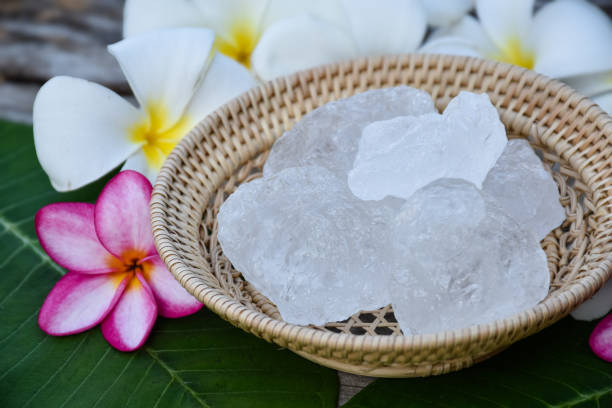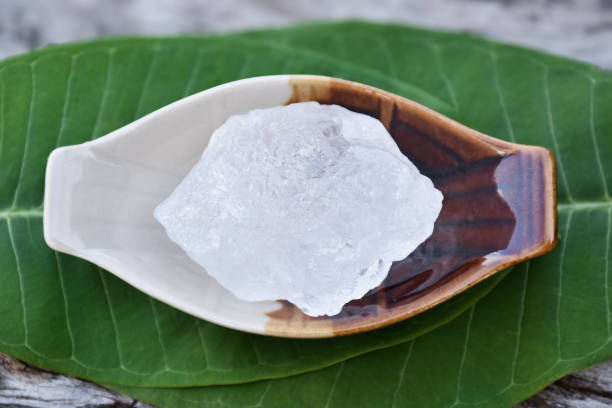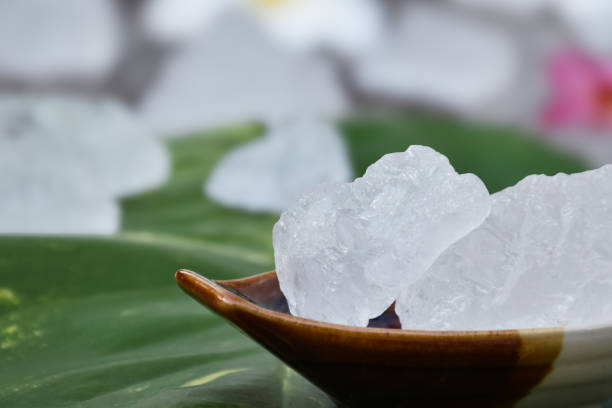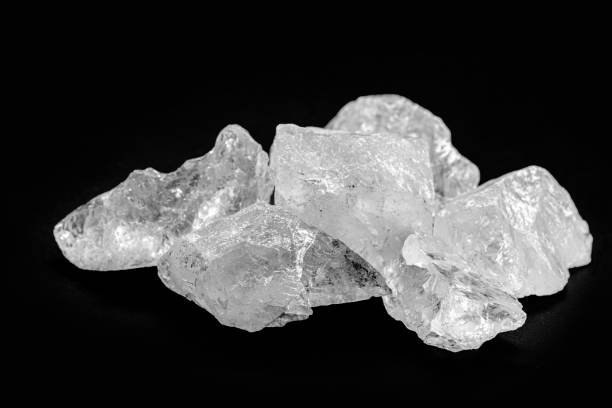Potassium aluminum sulfate, popularly known as potash alum or simply alum, is among the most widely utilized double salts in both chemistry and industry. Valued for its astringent, antiseptic, and coagulating qualities, it has been employed for centuries across diverse fields such as medicine, water treatment, textiles, and cosmetics. In this comprehensive guide, we will examine its structure, properties, methods of preparation, uses, benefits, drawbacks, and safety considerations.
Introduction to Potassium Aluminum Sulfate
Potassium aluminum sulfate (KAl(SO₄)₂·12H₂O) is a hydrated double salt formed by the combination of potassium sulfate (K₂SO₄) and aluminum sulfate (Al₂(SO₄)₃). It is most commonly found as dodecahydrate crystals, appearing as transparent, colorless solids with a slightly sweet, astringent taste.
- Chemical Formula: KAl(SO₄)₂·12H₂O
- Molar Mass: 474.39 g/mol
- Appearance: Colorless, transparent octahedral crystals.
- Solubility: Moderately soluble in water, insoluble in alcohol.
- Taste: Sweetish and astringent.
Chemical Structure of Potassium Aluminum Sulfate
Potassium aluminum sulfate belongs to the alum family, which is a hydrated double salt of monovalent and trivalent metals. Its structure is composed of potassium ions (K⁺), aluminum ions (Al³⁺), and sulfate ions (SO₄²⁻), bound together with 12 molecules of water of crystallization. This water content is crucial for its crystalline stability.
Preparation of Potassium Aluminum Sulfate

Potassium aluminum sulfate can be prepared both industrially and in laboratories:
1. Industrial Preparation
- Obtained by treating bauxite (Al₂O₃·xH₂O) with sulfuric acid to produce aluminum sulfate.
- Aluminum sulfate is then combined with a potassium sulfate solution to crystallize alum.
2. Laboratory Preparation
- Prepared by dissolving aluminum hydroxide in sulfuric acid to form an aluminum sulfate solution.
- Potassium sulfate is added to this solution.
- Upon cooling, large transparent crystals of potassium alum are formed.
Reaction:
Al₂O₃ + 3 H₂SO₄ → Al₂(SO₄)₃ + 3 H₂O
Al₂(SO₄)₃ + K₂SO₄ + 24 H₂O → 2 KAl(SO₄)₂·12H₂O
Physical and Chemical Properties
- Appearance: Colorless, transparent crystalline solid.
- Density: 1.725 g/cm³
- Melting Point: Loses water of crystallization around 92–95°C and decomposes at 200°C.
- Solubility: Soluble in hot water, sparingly soluble in cold water.
- pH: Slightly acidic solution in water.
- Taste: Astringent and mildly sweet.
Uses of Potassium Aluminum Sulfate
Potassium aluminum sulfate is valued for its versatility and wide range of applications:
1. Water Purification
- Functions as a coagulating agent to remove suspended impurities.
- Commonly used in municipal water treatment plants.
2. Medicine and Personal Care
- Works as an astringent and antiseptic.
- Used in styptic pencils to stop bleeding from minor cuts.
- Active ingredient in some deodorants and aftershaves.
- Relieves canker sores and minor wounds in traditional medicine.
3. Food Industry
- Acts as a food additive (E522).
- Used in pickling to maintain the crispness of fruits and vegetables.
- Stabilizer in baking powders and flour treatment.
4. Textile and Leather Industry
- Serves as a mordant in dyeing to fix dyes onto fabrics.
- Applied in the tanning process of leather for improved durability.
5. Laboratory and Education

- Frequently used in chemistry demonstrations for crystal growth experiments.
- Applied in protein purification as a precipitating agent.
6. Other Applications
- Used in paper manufacturing to improve quality.
- Acts as a flame retardant.
- An ingredient in some cosmetic and skincare formulations.
Advantages of Potassium Aluminum Sulfate
- Affordable and widely available in crystalline form.
- It acts as a dual-purpose compound (an astringent + coagulating agent).
- Long shelf life under proper storage conditions.
- Environmentally safer compared to some synthetic chemicals.
- Useful across multiple industries, making it a versatile product.
Disadvantages and Limitations
- Excessive use of alum in food can cause health concerns due to high aluminum intake.
- It may cause skin irritation in sensitive people.
- Solubility is limited in cold water, requiring heating for effective use.
- Prolonged contact may corrode metals.
Safety and Handling Precautions
While potassium aluminum sulfate is generally safe, certain precautions should be followed:
- Store in a cool, dry place away from moisture.
- Use protective gloves and eyewear while handling large amounts.
- Avoid direct inhalation of dust particles.
- Do not ingest in large quantities, as excessive aluminum may affect health.
Environmental Impact
- Biodegradable and does not accumulate in the environment.
- Safe for controlled water treatment processes.
- Overuse in soil or water may affect pH balance and harm aquatic ecosystems.
Comparison with Other Types of Alum
| Type of Alum | Composition | Common Uses |
|---|---|---|
| Potassium Alum | KAl(SO₄)₂·12H₂O | Water purification, medicine, food |
| Ammonium Alum | NH₄Al(SO₄)₂·12H₂O | Water purification, medicine, and food |
| Sodium Alum | NaAl(SO₄)₂·12H₂O | Paper industry, water treatment |
| Chrome Alum | KCr(SO₄)₂·12H₂O | Tanning leather, textile dyeing |
Future Prospects of Potassium Aluminum Sulfate

With growing demand for eco-friendly and sustainable compounds, potassium alum continues to hold significance in water purification, personal care, and food preservation. Its biodegradable nature and low toxicity compared to synthetic alternatives make it an attractive choice for industries aiming to reduce environmental impact. Research is also expanding its role in biotechnology and pharmaceuticals.
Conclusion
Potassium aluminum sulfate is a time-tested and versatile compound with immense benefits in agriculture, medicine, food, water treatment, and industry. Its coagulating, astringent, and antiseptic properties have ensured its use for centuries, and it remains indispensable in modern applications. By balancing its advantages with mindful usage, it continues to be a safe and valuable resource across various sectors.
What is Potassium Aluminum Sulfate?
Potassium aluminum sulfate, popularly known as potash alum or simply alum, is among the most widely utilized double salts in both chemistry and industry. Valued for its astringent, antiseptic, and coagulating qualities, it has been employed for centuries across diverse fields such as medicine, water treatment, textiles, and cosmetics. In this comprehensive guide, we will examine its structure, properties, methods of preparation, uses, benefits, drawbacks, and safety considerations.
Introduction to Potassium Aluminum Sulfate
Potassium aluminum sulfate (KAl(SO₄)₂·12H₂O) is a hydrated double salt formed by the combination of potassium sulfate (K₂SO₄) and aluminum sulfate (Al₂(SO₄)₃). It is most commonly found as dodecahydrate crystals, appearing as transparent, colorless solids with a slightly sweet, astringent taste.
Chemical Formula: KAl(SO₄)₂·12H₂O
Molar Mass: 474.39 g/mol
Appearance: Colorless, transparent octahedral crystals.
Solubility: Moderately soluble in water, insoluble in alcohol.
Taste: Sweetish and astringent.
Chemical Structure of Potassium Aluminum Sulfate
Potassium aluminum sulfate belongs to the alum family, which is a hydrated double salt of monovalent and trivalent metals. Its structure is composed of potassium ions (K⁺), aluminum ions (Al³⁺), and sulfate ions (SO₄²⁻), bound together with 12 molecules of water of crystallization. This water content is crucial for its crystalline stability.
Preparation of Potassium Aluminum Sulfate
Potassium aluminum sulfate can be prepared both industrially and in laboratories:
1. Industrial Preparation
Obtained by treating bauxite (Al₂O₃·xH₂O) with sulfuric acid to produce aluminum sulfate.
Aluminum sulfate is then combined with a potassium sulfate solution to crystallize alum.
2. Laboratory Preparation
Prepared by dissolving aluminum hydroxide in sulfuric acid to form an aluminum sulfate solution.
Potassium sulfate is added to this solution.
Upon cooling, large transparent crystals of potassium alum are formed.
Reaction:
Al₂O₃ + 3 H₂SO₄ → Al₂(SO₄)₃ + 3 H₂O
Al₂(SO₄)₃ + K₂SO₄ + 24 H₂O → 2 KAl(SO₄)₂·12H₂O
Physical and Chemical Properties
Appearance: Colorless, transparent crystalline solid.
Density: 1.725 g/cm³
Melting Point: Loses water of crystallization around 92–95°C and decomposes at 200°C.
Solubility: Soluble in hot water, sparingly soluble in cold water.
pH: Slightly acidic solution in water.
Taste: Astringent and mildly sweet.
Uses of Potassium Aluminum Sulfate
Potassium aluminum sulfate is valued for its versatility and wide range of applications:
1. Water Purification
Functions as a coagulating agent to remove suspended impurities.
Commonly used in municipal water treatment plants.
2. Medicine and Personal Care
Works as an astringent and antiseptic.
Used in styptic pencils to stop bleeding from minor cuts.
Active ingredient in some deodorants and aftershaves.
Relieves canker sores and minor wounds in traditional medicine.
3. Food Industry
Acts as a food additive (E522).
Used in pickling to maintain the crispness of fruits and vegetables.
Stabilizer in baking powders and flour treatment.
4. Textile and Leather Industry
Serves as a mordant in dyeing to fix dyes onto fabrics.
Applied in the tanning process of leather for improved durability.
5. Laboratory and Education
Frequently used in chemistry demonstrations for crystal growth experiments.
Applied in protein purification as a precipitating agent.
6. Other Applications
Used in paper manufacturing to improve quality.
Acts as a flame retardant.
An ingredient in some cosmetic and skincare formulations.
Advantages of Potassium Aluminum Sulfate
Affordable and widely available in crystalline form.
It acts as a dual-purpose compound (an astringent + coagulating agent).
Long shelf life under proper storage conditions.
Environmentally safer compared to some synthetic chemicals.
Useful across multiple industries, making it a versatile product.
Disadvantages and Limitations
Excessive use of alum in food can cause health concerns due to high aluminum intake.
It may cause skin irritation in sensitive people.
Solubility is limited in cold water, requiring heating for effective use.
Prolonged contact may corrode metals.
Safety and Handling Precautions
While potassium aluminum sulfate is generally safe, certain precautions should be followed:
Store in a cool, dry place away from moisture.
Use protective gloves and eyewear while handling large amounts.
Avoid direct inhalation of dust particles.
Do not ingest in large quantities, as excessive aluminum may affect health.
Environmental Impact
Biodegradable and does not accumulate in the environment.
Safe for controlled water treatment processes.
Overuse in soil or water may affect pH balance and harm aquatic ecosystems.
Comparison with Other Types of Alum
| Type of Alum | Composition | Common Uses |
|---|---|---|
| Potassium Alum | KAl(SO₄)₂·12H₂O | Water purification, medicine, food |
| Ammonium Alum | NH₄Al(SO₄)₂·12H₂O | Water purification, medicine, and food |
| Sodium Alum | NaAl(SO₄)₂·12H₂O | Paper industry, water treatment |
| Chrome Alum | KCr(SO₄)₂·12H₂O | Tanning leather, textile dyeing |
Future Prospects of Potassium Aluminum Sulfate
With growing demand for eco-friendly and sustainable compounds, potassium alum continues to hold significance in water purification, personal care, and food preservation. Its biodegradable nature and low toxicity compared to synthetic alternatives make it an attractive choice for industries aiming to reduce environmental impact. Research is also expanding its role in biotechnology and pharmaceuticals.
Conclusion
Potassium aluminum sulfate is a time-tested and versatile compound with immense benefits in agriculture, medicine, food, water treatment, and industry. Its coagulating, astringent, and antiseptic properties have ensured its use for centuries, and it remains indispensable in modern applications. By balancing its advantages with mindful usage, it continues to be a safe and valuable resource across various sectors.
Is alum environmentally safe?
What are the limitations of alum?
Not suitable for people with sensitive skin
Limited effectiveness against some modern water contaminants
What are the advantages of alum?
Natural antiseptic and astringent
Affordable and widely available
Useful in multiple industries
What industries use potassium aluminum sulfate?
Can alum be used on the skin?
How does alum purify water?
Is alum safe for daily use?
What are the common uses of potash alum?
What is the chemical formula of alum?
What is potassium aluminum sulfate used for?
Potassium aluminum sulfate, popularly known as potash alum or simply alum, is among the most widely utilized double salts in both chemistry and industry. Valued for its astringent, antiseptic, and coagulating qualities, it has been employed for centuries across diverse fields such as medicine, water treatment, textiles, and cosmetics. In this comprehensive guide, we will examine its structure, properties, methods of preparation, uses, benefits, drawbacks, and safety considerations.
Introduction to Potassium Aluminum Sulfate
Potassium aluminum sulfate (KAl(SO₄)₂·12H₂O) is a hydrated double salt formed by the combination of potassium sulfate (K₂SO₄) and aluminum sulfate (Al₂(SO₄)₃). It is most commonly found as dodecahydrate crystals, appearing as transparent, colorless solids with a slightly sweet, astringent taste.
Chemical Formula: KAl(SO₄)₂·12H₂O
Molar Mass: 474.39 g/mol
Appearance: Colorless, transparent octahedral crystals.
Solubility: Moderately soluble in water, insoluble in alcohol.
Taste: Sweetish and astringent.
Chemical Structure of Potassium Aluminum Sulfate
Potassium aluminum sulfate belongs to the alum family, which is a hydrated double salt of monovalent and trivalent metals. Its structure is composed of potassium ions (K⁺), aluminum ions (Al³⁺), and sulfate ions (SO₄²⁻), bound together with 12 molecules of water of crystallization. This water content is crucial for its crystalline stability.
Preparation of Potassium Aluminum Sulfate
Potassium aluminum sulfate can be prepared both industrially and in laboratories:
1. Industrial Preparation
Obtained by treating bauxite (Al₂O₃·xH₂O) with sulfuric acid to produce aluminum sulfate.
Aluminum sulfate is then combined with a potassium sulfate solution to crystallize alum.
2. Laboratory Preparation
Prepared by dissolving aluminum hydroxide in sulfuric acid to form an aluminum sulfate solution.
Potassium sulfate is added to this solution.
Upon cooling, large transparent crystals of potassium alum are formed.
Reaction:
Al₂O₃ + 3 H₂SO₄ → Al₂(SO₄)₃ + 3 H₂O
Al₂(SO₄)₃ + K₂SO₄ + 24 H₂O → 2 KAl(SO₄)₂·12H₂O
Physical and Chemical Properties
Appearance: Colorless, transparent crystalline solid.
Density: 1.725 g/cm³
Melting Point: Loses water of crystallization around 92–95°C and decomposes at 200°C.
Solubility: Soluble in hot water, sparingly soluble in cold water.
pH: Slightly acidic solution in water.
Taste: Astringent and mildly sweet.
Uses of Potassium Aluminum Sulfate
Potassium aluminum sulfate is valued for its versatility and wide range of applications:
1. Water Purification
Functions as a coagulating agent to remove suspended impurities.
Commonly used in municipal water treatment plants.
2. Medicine and Personal Care
Works as an astringent and antiseptic.
Used in styptic pencils to stop bleeding from minor cuts.
Active ingredient in some deodorants and aftershaves.
Relieves canker sores and minor wounds in traditional medicine.
3. Food Industry
Acts as a food additive (E522).
Used in pickling to maintain the crispness of fruits and vegetables.
Stabilizer in baking powders and flour treatment.
4. Textile and Leather Industry
Serves as a mordant in dyeing to fix dyes onto fabrics.
Applied in the tanning process of leather for improved durability.
5. Laboratory and Education
Frequently used in chemistry demonstrations for crystal growth experiments.
Applied in protein purification as a precipitating agent.
6. Other Applications
Used in paper manufacturing to improve quality.
Acts as a flame retardant.
An ingredient in some cosmetic and skincare formulations.
Advantages of Potassium Aluminum Sulfate
Affordable and widely available in crystalline form.
It acts as a dual-purpose compound (an astringent + coagulating agent).
Long shelf life under proper storage conditions.
Environmentally safer compared to some synthetic chemicals.
Useful across multiple industries, making it a versatile product.
Disadvantages and Limitations
Excessive use of alum in food can cause health concerns due to high aluminum intake.
It may cause skin irritation in sensitive people.
Solubility is limited in cold water, requiring heating for effective use.
Prolonged contact may corrode metals.
Safety and Handling Precautions
While potassium aluminum sulfate is generally safe, certain precautions should be followed:
Store in a cool, dry place away from moisture.
Use protective gloves and eyewear while handling large amounts.
Avoid direct inhalation of dust particles.
Do not ingest in large quantities, as excessive aluminum may affect health.
Environmental Impact
Biodegradable and does not accumulate in the environment.
Safe for controlled water treatment processes.
Overuse in soil or water may affect pH balance and harm aquatic ecosystems.
Comparison with Other Types of Alum
| Type of Alum | Composition | Common Uses |
|---|---|---|
| Potassium Alum | KAl(SO₄)₂·12H₂O | Water purification, medicine, food |
| Ammonium Alum | NH₄Al(SO₄)₂·12H₂O | Water purification, medicine, and food |
| Sodium Alum | NaAl(SO₄)₂·12H₂O | Paper industry, water treatment |
| Chrome Alum | KCr(SO₄)₂·12H₂O | Tanning leather, textile dyeing |
With growing demand for eco-friendly and sustainable compounds, potassium alum continues to hold significance in water purification, personal care, and food preservation. Its biodegradable nature and low toxicity compared to synthetic alternatives make it an attractive choice for industries aiming to reduce environmental impact. Research is also expanding its role in biotechnology and pharmaceuticals.
Conclusion
Potassium aluminum sulfate is a time-tested and versatile compound with immense benefits in agriculture, medicine, food, water treatment, and industry. Its coagulating, astringent, and antiseptic properties have ensured its use for centuries, and it remains indispensable in modern applications. By balancing its advantages with mindful usage, it continues to be a safe and valuable resource across various sectors.
